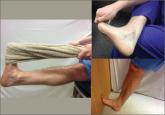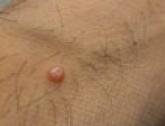Clinical Review

Plantar Fasciitis: How Best to Treat?
In addition to stretching exercises and orthotics, consider steroid injections as part of your first-line treatment options. For recalcitrant pain...
Dr. Zaiac is from the Department of Dermatology, Herbert Wertheim College of Medicine, Florida International University, Miami Beach. Ms. Mlacker, Ms. Shah, and Mr. Simmons are from the Department of Dermatology and Cutaneous Surgery, University of Miami Miller School of Medicine.
The authors report no conflict of interest.
Correspondence: Stephanie Mlacker, BS, University of Miami Miller School of Medicine, Department of Dermatology and Cutaneous Surgery, 1475 NW 12th Ave, Miami, FL 33136 (mlackerstephanie@gmail.com).

Plantar warts can be distinguished from calluses using the squeeze maneuver, a quick and easy method to diagnose plantar warts. This technique negates the need for an expensive diagnostic tool.
Practice Gap
Warts may negatively impact a patient's quality of life, as they may cause not only discomfort and pain but also embarrassment and low self-esteem.1 Moreover, Ciconte et al1 demonstrated that study participants with warts on their feet were more likely to report physical discomfort than those with warts on their hands. Therefore, plantar warts should be diagnosed promptly to allow for proper treatment.
Warts may be identified by viewing the dilated capillaries that lie on their surface, which appear as small black dots to the naked eye.1 The formation of a plantar wart obliterates the normal plantar creases, thereby flattening the skin’s natural markings. However, a plantar wart may appear clinically similar to a callus and both lesions typically form in pressure point areas, warranting the use of a tool that aids in its diagnostic evaluation.1,2
Diagnostic Tools
Dermoscopy, a noninvasive tool that creates a microscopic visualization of lesions, is commonly used to distinguish dermatologic pathology if the clinical presentation overlaps with a similar lesion, such as a callus, corn, or plantar wart.1,3 However, there is another way of differentiating plantar warts from calluses using a simple 2-step clinical maneuver that we learned from Dr. Lewis Kaplan at the University of Miami.
Using the thumb or index finger, apply pressure at a perpendicular angle to the lesion on the sole of the patient’s foot, which will not create substantial discomfort or pain in a patient who has a plantar wart (Figure) but will be painful in a patient who has a callus due to the underlying bony spur. The next step involves applying pressure to the left and right sides of the lesion by squeezing toward the center with the thumb and index finger at a 45° angle. This maneuver will create substantial discomfort and pain in patients with plantar warts, thus helping to confirm the diagnosis.
| A plantar wart before (A) and after undergoing the squeeze maneuver (B). The patient denied feelings of discomfort or pain. | |
Practice Implications
Rarely, a plantar wart can progress to form a verrucous carcinoma if left untreated.2 Thus, it is important to diagnose and treat plantar warts to avoid pain and potential complications. The technique discussed here, which we are coining as the “squeeze maneuver,” allows for easy diagnosis and negates the need for an expensive diagnostic tool.To submit a clinical pearl, contact our Editorial Office.

In addition to stretching exercises and orthotics, consider steroid injections as part of your first-line treatment options. For recalcitrant pain...
For patients presenting with classic features of plantar fibromatosis, a presumptive diagnosis may be made on clinical grounds alone. In less...

Molluscum contagiosum (MC) is a skin infection caused by the double-stranded DNA virus of the family Poxviridae that typically presents as flesh-...
